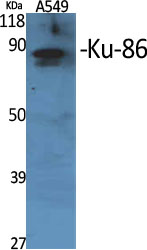Progesterone receptor (PR)-FC recombinant protein
- Catalog No.:YD3022
- Reactivity:Human;
- Purity:
- >90% as determined by SDS-PAGE
- Gene Name:
- PGR
- Protein Name:
- Progesterone receptor (PR) (Nuclear receptor subfamily 3 group C member 3)
- Sequence:
- Amino acid:165-305,with FC tag.
- Human Gene Id:
- 5241
- Human Swiss Prot No:
- P06401
- Formulation:
- Phosphate-buffered solution
- Source:
- Mammalian cells
- Storage Stability:
- -15°C to -25°C/1 year(Avoid freeze / thaw cycles)
- Other Name:
- Progesterone receptor ;PR;Nuclear receptor subfamily 3 group C member 3;PGR;NR3C3;
- Function:
- The steroid hormones and their receptors are involved in the regulation of eukaryotic gene expression and affect cellular proliferation and differentiation in target tissues. Depending on the isoform, progesterone receptor functions as a transcriptional activator or repressor.; [Isoform A]: Ligand-dependent transdominant repressor of steroid hormone receptor transcriptional activity including repression of its isoform B, MR and ER. Transrepressional activity may involve recruitment of corepressor NCOR2.; [Isoform B]: Transcriptional activator of several progesteron-dependent promoters in a variety of cell types. Involved in activation of SRC-dependent MAPK signaling on hormone stimulation.; [Isoform 4]: Increases mitochondrial membrane potential and cellular respiration upon stimulation by progesterone.
- Subcellular Location:
- Nucleus. Cytoplasm. Note=Nucleoplasmic shuttling is both hormone- and cell cycle-dependent. On hormone stimulation, retained in the cytoplasm in the G(1) and G(2)/M phases.; [Isoform A]: Nucleus. Cytoplasm. Note=Mainly nuclear.; [Isoform 4]: Mitochondrion outer membrane .
- Expression:
- In reproductive tissues the expression of isoform A and isoform B varies as a consequence of developmental and hormonal status. Isoform A and isoform B are expressed in comparable levels in uterine glandular epithelium during the proliferative phase of the menstrual cycle. Expression of isoform B but not of isoform A persists in the glands during mid-secretory phase. In the stroma, isoform A is the predominant form throughout the cycle. Heterogeneous isoform expression between the glands of the endometrium basalis and functionalis is implying region-specific responses to hormonal stimuli.
- June 19-2018
- WESTERN IMMUNOBLOTTING PROTOCOL
- June 19-2018
- IMMUNOHISTOCHEMISTRY-PARAFFIN PROTOCOL
- June 19-2018
- IMMUNOFLUORESCENCE PROTOCOL
- September 08-2020
- FLOW-CYTOMEYRT-PROTOCOL
- May 20-2022
- Cell-Based ELISA│解您多样本WB检测之困扰
- July 13-2018
- CELL-BASED-ELISA-PROTOCOL-FOR-ACETYL-PROTEIN
- July 13-2018
- CELL-BASED-ELISA-PROTOCOL-FOR-PHOSPHO-PROTEIN
- July 13-2018
- Antibody-FAQs

